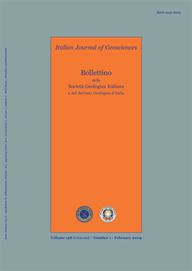
Late Quaternary deformation of the southern Adriatic foreland (southern Apulia) from mesostructural data: preliminary results
Daniela Di Bucci(*), Stella Coccia(**), Umberto Fracassi(***), Vincenzo Iurilli(**), Giuseppe Mastronuzzi(**), Giovanni Palmentola(**), Paolo Sansò(****), Gianluca Selleri(****) & Gianluca Valensise(***)
(*) Dipartimento della Protezione Civile. Via Vitorchiano, 4 - 00189 Roma, Italy. E-mail: daniela.dibucci@protezionecivile.it
(**) Università degli Studi di Bari, Campus Universitario, Dipartimento di Geologia e Geofisica. Via Orabona, 4 - 70125 Bari, Italy.
(***) Istituto Nazionale di Geofisica e Vulcanologia. Via di Vigna Murata, 605 - 00143 Roma, Italy.
(****) Università degli Studi di Lecce, Dipartimento di Scienza dei Materiali, Osservatorio di Fisica, Chimica e Geologia Ambientale. Via per Arnesano - 73100 Lecce, Italy
Volume: 128 (2009) f.1
Pages: 33-46
Abstract
Southern Apulia (Adriatic foreland, Italy), has long been considered a «stable area» lying in between two active orogens, but in fact its tectonic framework is poorly known. To learn more about this topic, we carried out an original structural analysis on Pleistocene deposits. The results indicate that southern Apulia has been affected by mild but discernible brittle deformation throughout the Middle and Late Pleistocene. Joints prevail, whereas faults are rare and all characterized by small displacement. Horizontal extension dominates throughout the entire study area; the SW-NE to SSW-NNE direction is the most widespread. WNW-ESE extension prevails in the Adriatic side portion of the study area, but the dispersion of the measured plane directions is high, suggesting that the local strain field is not characterized by a strongly predominant trend. A Middle and Late Pleistocene, SW-NE to SSW-NNE-oriented maximum extension is not surprising for the study area, as it is compatible with most of the available geodynamic models, whereas the different state of deformation affecting the Adriatic side of the study area requires further investigations. We tentatively interpreted this anomaly as reflecting some regional variation of the general geodynamic frame, for instance as the farthest evidence of ongoing compressional deformation across the W-verging Albanide-Hellenide fold-and-thrust belt.
Keywords
Get Full Text